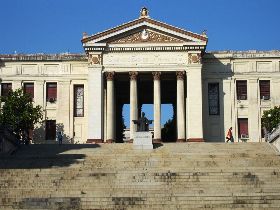After a century and a half, in 1728, in the same place and the same religious order of the Dominicans, founded the first university in the island
With the support of the council and of the powerful family of the Counts of Casa Bayona residents in the city, the Dominicans, engaged in educational activities – pioneered practice as teachers in these parts – managed the approvals that were required as a sine qua non to found a university in their properties.
As there is no general studies institution in the country, the existence of such center became must for those who lived in and wanted to complete the teaching, and prepare as jurists, theologians or doctors.
To finish a career , the residents of the island always faithful had no choice but to attend the University of Salamanca , on the peninsula , or pilgrimage to that of Mexico , Peru and Santo Domingo , the only places in the New World where these they were.
The corresponding papal bull – Aeternae Sapientiae – authorizing Dominicans to found the university was issued by Pope Innocent XIII in 1721, and King Philip V of Bourbon, through the Council of the Indies, was cleared – placet – confirmed it by royal decree in 1728.
The process to achieve the desired institution had been long and very aware of the religious, as the first steps requesting its creation had taken place in the year 1688, although some historical sources point to 1670 as the time when the Order of Preachers gave beginnings to its efforts to get that privilege.
The long journey was not without foundation competition and rivalry. Similarly, the Society of Jesus, applied and well recognized in instructional tasks and open school in Havana from 1724, aspired to the waiver and even had its patron in the Bishop Jerónimo Valdés , who undoubtedly favored the Jesuits.
According to Antonio Bachiller y Morales says in his Notes on the History of Literature and Public Education in the Island of Cuba, when the news of authorization reached the Villa was universal rejoicing, manifesting with parties and public demonstrations.
On January 5, 1728, in place of privilege that the Order had chosen to locate Dominica their convent of San Juan de Letran, close to the Plaza de Armas and the Castillo de la Real Fuerza , with touches of bells and all formalities and solemnities possible at the time, was born in the likeness of the one in Santo Domingo in the Spanish , the Royal and Pontifical University of San Geronimo of Havana , which initially had some faculties or chairs . It almost entirely taught by Dominican priests.
The classes generally were only theoretical, with readings of texts that were taught in Latin and memorize.
In 1842 the Dominicans were secularized in their convent, and the building and the university that existed became the property of the Government of Cuba.
With the secularization of the Royal and Pontifical University this became the Royal and Literary University of Havana, but other deeper reforms are perceived.
These began with the chairs outside the university as the Political Economy of Just Velez, promoted by the Creole elite , and education in schools as José de la Luz y Caballero, which advocated a free and modern education scholasticism , or by the teachings of Jose Agustin y Caballero, Felix Varela and Jose Antonio Saco from the Seminary of San Carlos and San Ambrosio , where nature and life itself proved object of knowledge and science , a practice that gave an education transit conscience of the nation.
Translated by: Daysi Olano



